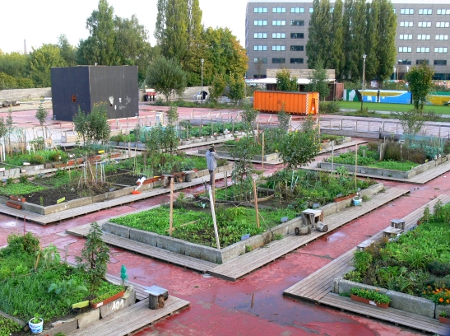Lesson: Map the Green Space
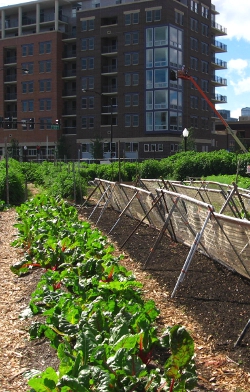 (Lesson modified from Cooper-Hewitt Educator Resource Center and Lisa Liu). [See modification by Guthrie Green, an outdoor park and education center in Tulsa, Oklahoma’s Brady Arts District, that emphasizes “community inventory” as an English Language Arts/literacy lesson for grades 6-8.]
(Lesson modified from Cooper-Hewitt Educator Resource Center and Lisa Liu). [See modification by Guthrie Green, an outdoor park and education center in Tulsa, Oklahoma’s Brady Arts District, that emphasizes “community inventory” as an English Language Arts/literacy lesson for grades 6-8.]
Level: Grades 5-9.
Time Required: 3-4 class periods. Activity 1: 30 minutes, Activities 2 and 3: 60-90 minutes each
Introduction: Students in grades 5-9 learn about urban planning as they assess the environmental health of their community, taking a walk around their neighborhood. The lesson aims to help them become aware of the area’s “green” strengths and weaknesses through a series of activities that can be done jointly or independently.
First, they evaluate how people interact with their environment in both positive and negative ways. They take a critical look at everyday activities to determine whether better alternatives need to be encouraged.
Next, students focus tour their school neighborhood, with camera and worksheets in hand. They produce a report of their results, either through a portfolio or an annotated map. Finally, they propose ways to strengthen the community’s environmental setting. Do we value open green spaces as much as commercial or residential properties?
National Standards:
Science: Science as Inquiry — Ask a question about objects, organisms, and events in the environment
Please see Cooper-Hewitt lesson for standards in Social Studies, Language Arts, and Visual Arts (K-4) 1.
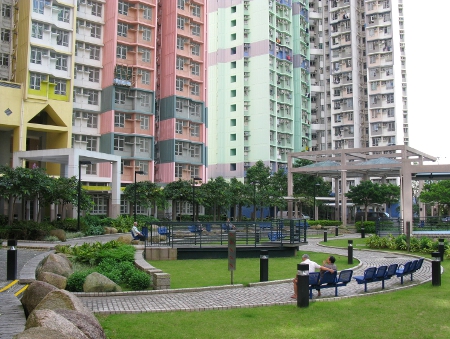 A city park near high-rise apartments
A city park near high-rise apartments
Objectives:
Students will:
- evaluate positive and negative interactions between individuals and their community
- identify different types of green spaces in their community
- learn about the benefit of green spaces to the environment
- design a portfolio presentation or annotated map
Materials:
- Communuty Inventory Worksheet
- Green Spaces Worksheet
- photocopied maps of neighborhood
- disposable or borrowed cameras
- large copies of maps for bulletin board display
- clipboards (optional)
- colored stickers or GreenMap icons
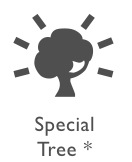 Vocabulary:
Vocabulary:
- Community
- Strengths
- Weaknesses
- Trees
- Streetscapes
- Parks
- Wildlife refuge/habitat gardens
- Gardens
Introduction:
Inform the class that their goal will be to examine their school’s community space and how well it functions — for the surrounding nature, as well as for the people living and working in it.
Pre-lesson Considerations:
- For schools at a distance from their communities, or for those with geographically dispersed student populations, the class might focus upon a key location of the town or city.
- Teachers need to plan ahead to ensure smooth execution of the neighborhood tour in activity #2. Parents, older students, or school volunteers can be enlisted to help student groups, particularly in recording the specific location of each photograph.
- While inexpensive disposable cameras can be used for this activity, equipment could also be borrowed. Safeguard the equipment by designating an official photographer from within the group.
Activity 1: Community Inventory
1. Write “community” on the board, soliciting students’ ideas of this concept as you create a semantic web of what community means to them.
2. Define the area boundaries, then project an image of the space or distribute photocopied maps for the students to study — how familiar are students with the space? What are its community strengths and weaknesses? Define “community strengths” as the ways people work to improve the environment and the aspects of the community that are beneficial to the environment. Define “community weaknesses” as ways in which people are harming or neglecting their environment.
3. Have students record the definitions and the ideas raised in the brainstorming session on their Community Inventory Worksheet.
4. Have students identify the area’s green spaces on distributed, photocopied maps. Help them define five basic green spaces, such as a park, garden, tree, wildlife refuge/habitat garden, or streetscape. Allow 10 to 20 minutes to complete the worksheet.
5. Have the class discuss the key green spaces they identified, as well as the community strengths and weaknesses in interacting with these spaced.
6. Brainstorm possible ways to address the weaknesses and to protect and enhance community strengths.
Activity 2: Neighborhood Walking Tour
- one disposable or borrowed camera
- two Green Spaces Worksheet
- a photocopied map
- clipboards (optional)
1. Before the students undertake their tour, ask them to list the green spaces they will see or interact with in their neighborhood.
2. Categorize the places the students mention as a park, garden, tree, wildlife refuge/habitat garden, or streetscape. Older students can develop a more varied and complex list, such as those used by GreenMap, an online mapping project.
3. Break the students into small groups for the walk to record their observations. Each group should carry a camera, a neighborhood map, and two copies of the Green Spaces Worksheet upon which to record their pictures and notes. Help students organize to decide who will be in charge of which materials.
4. Explain their task of photographing and recording notes about:
a) green spaces (park, garden, tree, wildlife refuge/habitat garden, or streetscape)
b) people interacting with their environment
c) strengths and weaknesses (elements that help or harm the environment)
Each group should aim to record at least five images.
Remind them to jot down quick notes on the worksheet to help them recall important aspects of what they have photographed, and to specify the location of each image.
They may also want to take a few “overview” photographs to capture the overall impression of a street and area.
Activity 3: Evaluating the Community Space
After conducting the walking tour, the teacher and students should prepare their materials for the next activity: producing a report of their findings. Teachers may need some adult help to guide students in downloading their pictures and printing them out, or taking film to be processed.
Teachers can choose to have students produce their report in the form of a portfolio or of an annotated map.
![]() 1. Portfolio of community strengths and weaknesses
1. Portfolio of community strengths and weaknesses
Materials for each group:
- students photographs
- completed Green Spaces worksheets, for reference
- paper supplies for portfolio construction
- GreenMap icons sheets
a) Using the GreenMap icons sheets for reference, have the class decide upon a few key categories of community strengths and of weaknesses they discovered during their walk.
b) Each group will prepare a portfolio that highlight up to 5 chosen categories of community strengths and of weaknesses. Each portfolio will contain 5 pages, each illustrating one strength or weakness and containing:
- a photograph, with location clearly identified
- a GreenMap icon
- one paragraph of explanation, based on worksheet notes
- suggestions for improvement or action
Extensions:
- Have each group present their findings on one strength and one weakness. How many groups selected the same item? Which suggestions are the most promising for improvement?
- Select a representative portfolio page from each group and display each on a collective bulletin board display, keyed to an enlarged map of the neighborhood. Allow the students take the lead in designing the display.
- Undertake a class project to encourage neighborhood improvement for the community space.
2. Mapping the Community Green Spaces
- student photographs
- completed Green Spaces worksheets
- enlarged photocopied maps or graph paper
- colored pencils
- GreenMap icons or color coded stickers
- yarn
- graph paper (optional)
a) Present each group with a enlarged version of the neighborhood map. Students could also draw their own map on graph paper. Have them color in the green spaces.
b) Have students affix to the map GreenMap icons or colored stickers coded to the types of green spaces they identified on their walk (i.e. park, garden, tree, wildlife refuge/habitat garden, or streetscape).
c) Have the students attached their photographs to the sides of the map, and then attach a piece of yarn from each photograph to the matching location on the map.
d) Each group should prepare an oral or 1-2 page written report summarizing their findings, including recommendations for improvements of community space and its use.
Extensions:
- Have each group summarize their findings for the class. How many groups selected the same items? Which suggestions are the most promising for improvement?
- Have the class pool their efforts on a single out-size map that goes into more detail, using more GreenMap icons or students own drawings.
- Discuss, then execute, a plan of action — what project could the class undertake to encourage neighborhood response or appreciation for the community space?
- Help students explore online green maps from the Green Map System.
Assessment:
Evaluation of students’ participation in this lesson can be based on:
- Completion of “Community Inventory Worksheet” and “Green Spaces Worksheet”
- Oral responses to teacher questions
- Contribution to small group work and discussions
- Writing assessment
Additional Extensions
- Write a letter to your local newspaper convincing your community to take care of its green spaces, create more green spaces, and detailing the importance of green spaces.
- Research a green engineering solution. How have engineers helped improve communities? View the egfi student blog to discover, then present your findings on new, environmentally friendly inventions. What other devices and solutions could engineers contribute?
- Take a class trip to a Wildlife Refuge Center or similar site. Compare this environment to that of your neighborhood. What the relevance and importance of such centers?
- Develop projects to help green your home and/or school.
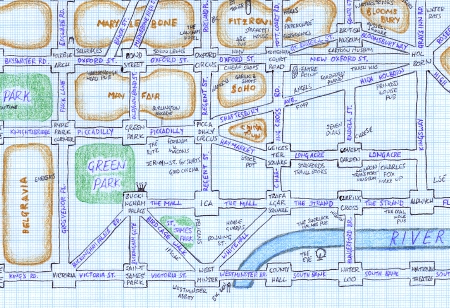
A hand-drawn map
Resources
On Green Maps from GreenMap.org:
Green maps provide a different perspective of residential areas. Instead of seeing only built areas of the local urban ecology, green maps locate waterways, wildlife habitat, parks, agricultural zones, recreational, cultural and historical sites, and other interesting places that make up a local environment. The online Green Map System is a global collaborative that assists people in constructing their own local Green Map. These online maps can be viewed on the Website.
Teacher Reflection (from the Cooper-Hewitt Lesson): The students responded well to the lessons, and could relate to the issues in them easily. Students were really struck by how negative human behavior really detracts from the beauty of a green space (e.g. trash in someone’s garden). For my students, this is a small part in a year-long look at community greening. They came in with lots of background. The most difficult part of this lesson was having the students record the location of where they took the pictures on the Green Spaces worksheet so that we could match up the location once the pictures were developed. I imagine this aspect would be easier with older students. To improve on this, I would meet with the other adult leaders before the walk to inform them of how the locations should be recorded so that they can better help students. It is also important to recruit as many adult volunteers as possible to allow for smaller groups. Having students work in small groups for discussions was successful. As students discussed, I was able to rotate between groups, make comments to each group, and encourage their ideas. Students were engaged and excited.
updated 2/20/17 by MCL
Filed under: Grades 6-8, Grades K-5, Lesson Plans
Tags: Community Awareness, ELA, Engineering Design, Environmental Engineering, Environmental science, Grades 5-9, Grades 6-8, Lesson Plan, literacy









